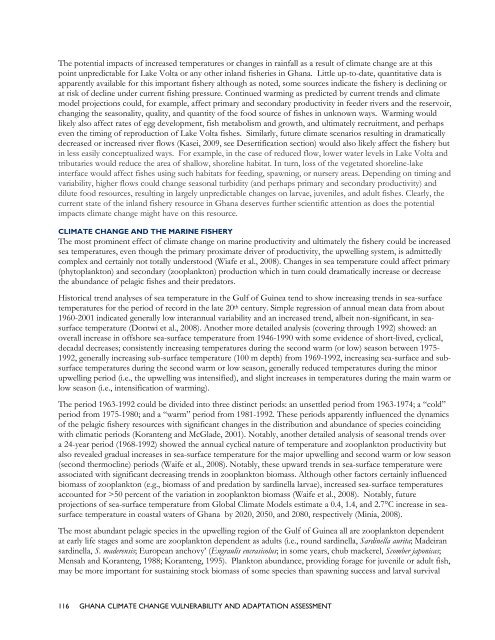ghana climate change vulnerability and adaptation assessment
ghana climate change vulnerability and adaptation assessment
ghana climate change vulnerability and adaptation assessment
- No tags were found...
Create successful ePaper yourself
Turn your PDF publications into a flip-book with our unique Google optimized e-Paper software.
The potential impacts of increased temperatures or <strong>change</strong>s in rainfall as a result of <strong>climate</strong> <strong>change</strong> are at thispoint unpredictable for Lake Volta or any other inl<strong>and</strong> fisheries in Ghana. Little up-to-date, quantitative data isapparently available for this important fishery although as noted, some sources indicate the fishery is declining orat risk of decline under current fishing pressure. Continued warming as predicted by current trends <strong>and</strong> <strong>climate</strong>model projections could, for example, affect primary <strong>and</strong> secondary productivity in feeder rivers <strong>and</strong> the reservoir,changing the seasonality, quality, <strong>and</strong> quantity of the food source of fishes in unknown ways. Warming wouldlikely also affect rates of egg development, fish metabolism <strong>and</strong> growth, <strong>and</strong> ultimately recruitment, <strong>and</strong> perhapseven the timing of reproduction of Lake Volta fishes. Similarly, future <strong>climate</strong> scenarios resulting in dramaticallydecreased or increased river flows (Kasei, 2009, see Desertification section) would also likely affect the fishery butin less easily conceptualized ways. For example, in the case of reduced flow, lower water levels in Lake Volta <strong>and</strong>tributaries would reduce the area of shallow, shoreline habitat. In turn, loss of the vegetated shoreline-lakeinterface would affect fishes using such habitats for feeding, spawning, or nursery areas. Depending on timing <strong>and</strong>variability, higher flows could <strong>change</strong> seasonal turbidity (<strong>and</strong> perhaps primary <strong>and</strong> secondary productivity) <strong>and</strong>dilute food resources, resulting in largely unpredictable <strong>change</strong>s on larvae, juveniles, <strong>and</strong> adult fishes. Clearly, thecurrent state of the inl<strong>and</strong> fishery resource in Ghana deserves further scientific attention as does the potentialimpacts <strong>climate</strong> <strong>change</strong> might have on this resource.CLIMATE CHANGE AND THE MARINE FISHERYThe most prominent effect of <strong>climate</strong> <strong>change</strong> on marine productivity <strong>and</strong> ultimately the fishery could be increasedsea temperatures, even though the primary proximate driver of productivity, the upwelling system, is admittedlycomplex <strong>and</strong> certainly not totally understood (Wiafe et al., 2008). Changes in sea temperature could affect primary(phytoplankton) <strong>and</strong> secondary (zooplankton) production which in turn could dramatically increase or decreasethe abundance of pelagic fishes <strong>and</strong> their predators.Historical trend analyses of sea temperature in the Gulf of Guinea tend to show increasing trends in sea-surfacetemperatures for the period of record in the late 20 th century. Simple regression of annual mean data from about1960-2001 indicated generally low interannual variability <strong>and</strong> an increased trend, albeit non-significant, in seasurfacetemperature (Dontwi et al., 2008). Another more detailed analysis (covering through 1992) showed: anoverall increase in offshore sea-surface temperature from 1946-1990 with some evidence of short-lived, cyclical,decadal decreases; consistently increasing temperatures during the second warm (or low) season between 1975-1992, generally increasing sub-surface temperature (100 m depth) from 1969-1992, increasing sea-surface <strong>and</strong> subsurfacetemperatures during the second warm or low season, generally reduced temperatures during the minorupwelling period (i.e., the upwelling was intensified), <strong>and</strong> slight increases in temperatures during the main warm orlow season (i.e., intensification of warming).The period 1963-1992 could be divided into three distinct periods: an unsettled period from 1963-1974; a “cold”period from 1975-1980; <strong>and</strong> a “warm” period from 1981-1992. These periods apparently influenced the dynamicsof the pelagic fishery resources with significant <strong>change</strong>s in the distribution <strong>and</strong> abundance of species coincidingwith climatic periods (Koranteng <strong>and</strong> McGlade, 2001). Notably, another detailed analysis of seasonal trends overa 24-year period (1968-1992) showed the annual cyclical nature of temperature <strong>and</strong> zooplankton productivity butalso revealed gradual increases in sea-surface temperature for the major upwelling <strong>and</strong> second warm or low season(second thermocline) periods (Waife et al., 2008). Notably, these upward trends in sea-surface temperature wereassociated with significant decreasing trends in zooplankton biomass. Although other factors certainly influencedbiomass of zooplankton (e.g., biomass of <strong>and</strong> predation by sardinella larvae), increased sea-surface temperaturesaccounted for >50 percent of the variation in zooplankton biomass (Waife et al., 2008). Notably, futureprojections of sea-surface temperature from Global Climate Models estimate a 0.4, 1.4, <strong>and</strong> 2.7°C increase in seasurfacetemperature in coastal waters of Ghana by 2020, 2050, <strong>and</strong> 2080, respectively (Minia, 2008).The most abundant pelagic species in the upwelling region of the Gulf of Guinea all are zooplankton dependentat early life stages <strong>and</strong> some are zooplankton dependent as adults (i.e., round sardinella, Sardinella aurita; Madeiransardinella, S. maderensis; European anchovy’ (Engraulis encrasicolus; in some years, chub mackerel, Scomber japonicas;Mensah <strong>and</strong> Koranteng, 1988; Koranteng, 1995). Plankton abundance, providing forage for juvenile or adult fish,may be more important for sustaining stock biomass of some species than spawning success <strong>and</strong> larval survival116 GHANA CLIMATE CHANGE VULNERABILITY AND ADAPTATION ASSESSMENT
















